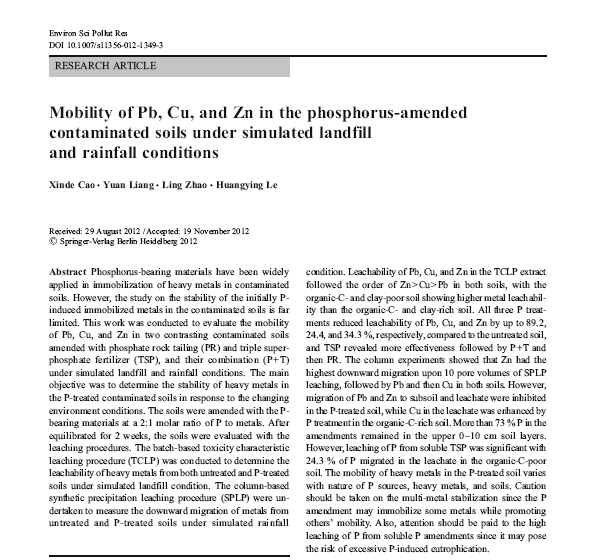Mobility of Pb, Cu, and Zn in the phosphorus-amended contaminated soils under simulated landfill and rainfall conditions
2017-11-27
Xinde Cao & Yuan Liang & Ling Zhao & Huangying Le
Abstract
Phosphorus-bearing materials have been widely applied in immobilization of heavy metals in contaminated soils. However, the study on the stability of the initially Pinduced immobilized metals in the contaminated soils is far limited. This work was conducted to evaluate the mobility of Pb, Cu, and Zn in two contrasting contaminated soils amended with phosphate rock tailing (PR) and triple superphosphate fertilizer (TSP), and their combination (P+T) under simulated landfill and rainfall conditions. The main objective was to determine the stability of heavy metals in the P-treated contaminated soils in response to the changing environment conditions. The soils were amended with the Pbearing materials at a 2:1 molar ratio of P to metals. After equilibrated for 2 weeks, the soils were evaluated with the leaching procedures. The batch-based toxicity characteristic leaching procedure (TCLP) was conducted to determine the leachability of heavy metals from both untreated and P-treated soils under simulated landfill condition. The column-based synthetic precipitation leaching procedure (SPLP) were undertaken to measure the downward migration of metals from untreated and P-treated soils under simulated rainfall condition. Leachability of Pb, Cu, and Zn in the TCLP extract followed the order of Zn>Cu>Pb in both soils, with the organic-C- and clay-poor soil showing higher metal leachability than the organic-C- and clay-rich soil. All three P treatments reduced leachability of Pb, Cu, and Zn by up to 89.2, 24.4, and 34.3 %, respectively, compared to the untreated soil, and TSP revealed more effectiveness followed by P+T and then PR. The column experiments showed that Zn had the highest downward migration upon 10 pore volumes of SPLP leaching, followed by Pb and then Cu in both soils. However, migration of Pb and Zn to subsoil and leachate were inhibited in the P treated soil, while Cu in the leachate was enhanced by P treatment in the organic-C-rich soil. More than 73%P in the amendments remained in the upper 0–10 cm soil layers. However, leaching of P from soluble TSP was significant with 24.3 % of P migrated in the leachate in the organic-C-poor soil. The mobility of heavy metals in the P-treated soil varies with nature of P sources, heavy metals, and soils. Caution should be taken on the multi-metal stabilization since the P amendment may immobilize some metals while promoting others’ mobility. Also, attention should be paid to the high leaching of P from soluble P amendments since it may pose the risk of excessive P-induced eutrophication.
